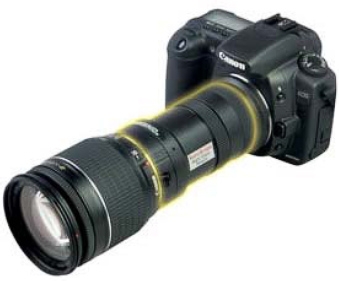
By Evan Ackerman
Adequate light has always been a problem for picture taking, which is why someone made the mistake of inventing the on-camera flash, spawning generations of washed out pictures filled with creepy red eyes. A much better way to go about taking pictures in the dark is with a more sensitive lens, but the more sensitive the lens gets, the bigger it has to be.
You can get around this practical limitation by cheating and using electronic enhancement, and the Electrophysics AstroScope 9350EOS-FF night vision module makes this just about as easy as possible by mounting snugly between your DSLR body and the lens of your choice. You can use telephoto lenses, macro lenses, tilt-shift lenses… The AstroScope preserves all the electronic connections between your camera and your lens and just sits there, amplifying photons as they pass through. It works just fine with image stabilization, draws a minimal amount of power from your battery, and is available for both Nikon and Canon DSLRs.
As far as price goes, Electrophysics thoughtfully answers that question in their FAQ:
Is the AstroScope expensive?
The AstroScope 9350-series products are cost effective modular solutions. We designed the AstroScope with modularity in mind to save you money and to “build in” a level of forwards compatibility. You can take advantage of the unique opportunity to “swap” our patented Gen III AstroScope common module Central Intensifier Unit from one night vision imaging platform to another (for example, use one CIU for both a camcorder and an SLR camera setup).
The only other problem with this night vision module is that it turns the whole image that exciting high-tech military fluorescent green color, which might cramp your style if you’re trying to, say, take pictures of animals at night. The solution, of course, is to go find animals that are green to begin with. Like, polar bears.
[ AstroScope ] VIA [ Photography Blog ]





wow.. its good to have a gadget like this with person like me that is very fun of photography…I'm a night person..and I want to capture clearly my night out fun.. =)
http://www.digitalslrcameralenses.net
wow.. its good to have a gadget like this with person like me that is very fun of photography…I'm a night person..and I want to capture clearly my night out fun.. =)
http://www.digitalslrcameralenses.net
wow.. its good to have a gadget like this with person like me that is very fun of photography…I'm a night person..and I want to capture clearly my night out fun.. =)
http://www.digitalslrcameralenses.net
wow.. its good to have a gadget like this with person like me that is very fun of photography…I'm a night person..and I want to capture clearly my night out fun.. =)
http://www.digitalslrcameralenses.net